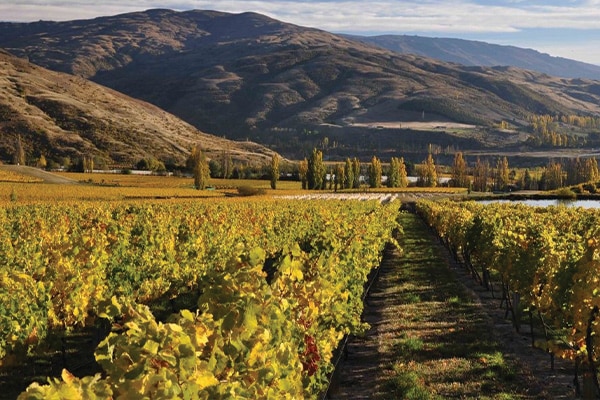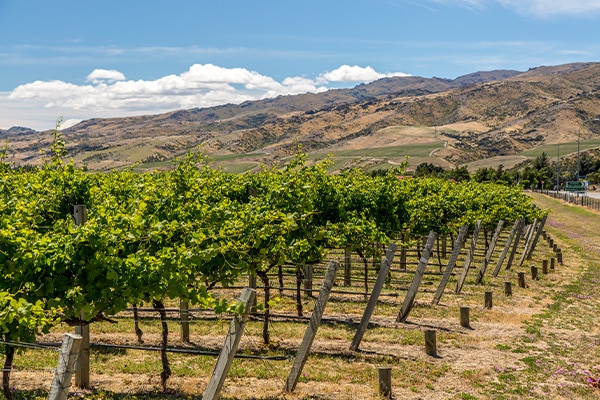Backdropped by serrated mountains, it’s a bucolically breath-taking place with big skies and sweeping views across the gold sluicings and the cascading wine terraces to the Kawarau River and Lake Dunstan. One of the best perches from which to soak it all up is at the Mt. Difficulty Cellar Door and Restaurant. It’s just one hot-spot for Instagram show-offery. My family booked in for lunch – reservations are highly recommended given the insatiable popularity. As a pinot noir devotee, you can’t go wrong with a premium pinot noir tasting tray, enabling you to sample five different pinot noirs, which I savoured while noshing on a sensational Mt. Difficulty Platter.
If there was a gold medal to be awarded for the splendour of the setting, Carrick would have to share the honours with Mt. Difficulty. Further east and overlooking the Bannockburn Inlet, close to Cornish Point, the winery takes its name from the neighbouring Carrick Range. The wines are estate-grown, wild fermented and certified organic. Small-batch quality is to the fore, with pinot noir making up 60% of their production. Order up a tasting and one of The Carrick’s famous Cairnmuir Platters, bursting with seasonal gourmet bites including manuka smoked sea run salmon, green lipped mussels and herb & corn frittatas. The outlook from their velvety grassy lawn, tumbling down to the water is stupendous, recently accentuated with the Lake Dunstan Trail threading the winery into its riveting route.
Another kick-ass haven of temptation is the evocative Bannockburn Hotel, which proudly was issued the first liquor licence in Central Otago. Dating back to 1862, superb food and wine is paired with knock-out scenic views across the storied countryside, as you indulge in the expansive beer gardens and terraced lawns, overlooking the elemental grandeur. Share plates and tapa style fare is all the rage here, superbly executed and artfully presented, tapping deep into local and seasonal produce. Trust me, this historic hotel is the sort of place you could easily while away a day at.
Like much of Central Otago, before vine time, Bannockburn first found fame during the gold rush, with miners flocking to the area’s rich alluvial gold field, mining extensively in the 1860s. As miners swept over the area, from 1862-1871 the face of the landscape underwent drastic changes as the alluvial flat was washed away by sluicing operations to the foreboding landscape that exists today. As much as human activity has radically altered the terrain, with all that large-scale water-blasting stripping the vegetation and laying bare the rocks, sands and soils, some parts of Bannockburn now resemble a miniature version of the Grand Canyon, with vast stone ridges – even mesas, naked and exposed in the golden-hued glory.
The locals like to call this vanished landscape New Zealand’s wild west and the upper heights of Bannockburn, that haven’t been wreathed in vineyards, do look like a teleported scene out of Arizona, New Mexico or Utah. When you enter Bannockburn, an enormous sign constructed from the original suspension bridge’s pillars across the Kawarau River, welcomes you to “The Heart of the Desert,” in deference to the bone-dry climate and fierce summer heat. Water during the gold rush period was a pivotal resource, not just for mining but to supply the town as well. Evidence of the complex water system that once existed is spread throughout the landscape, where huge dam walls and water races extend from high on the nearby Carrick Range down to the abandoned mining sites.
By Mike Yardley, read the full article on Newstalk ZB


